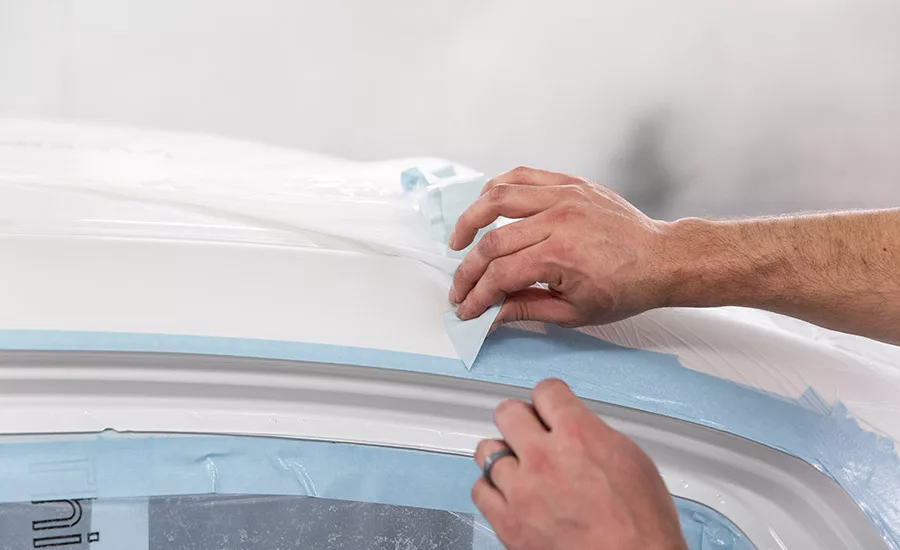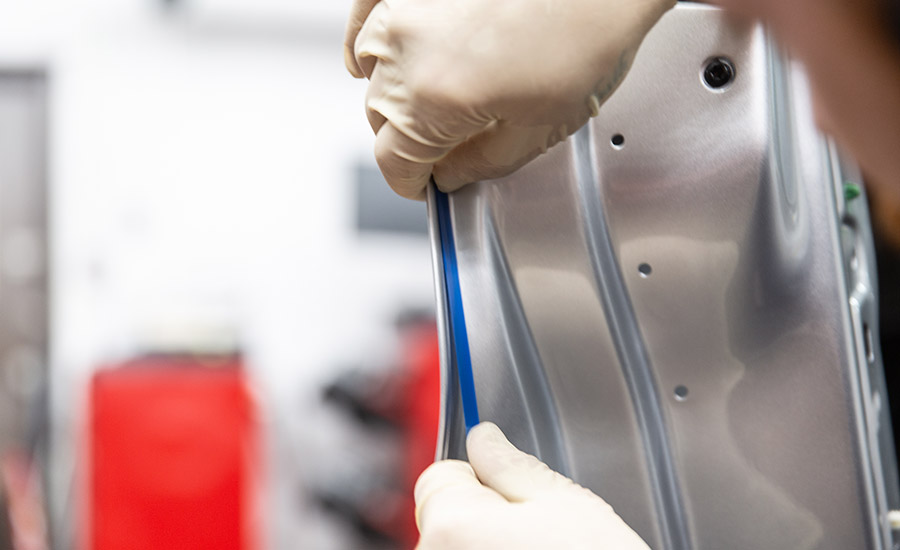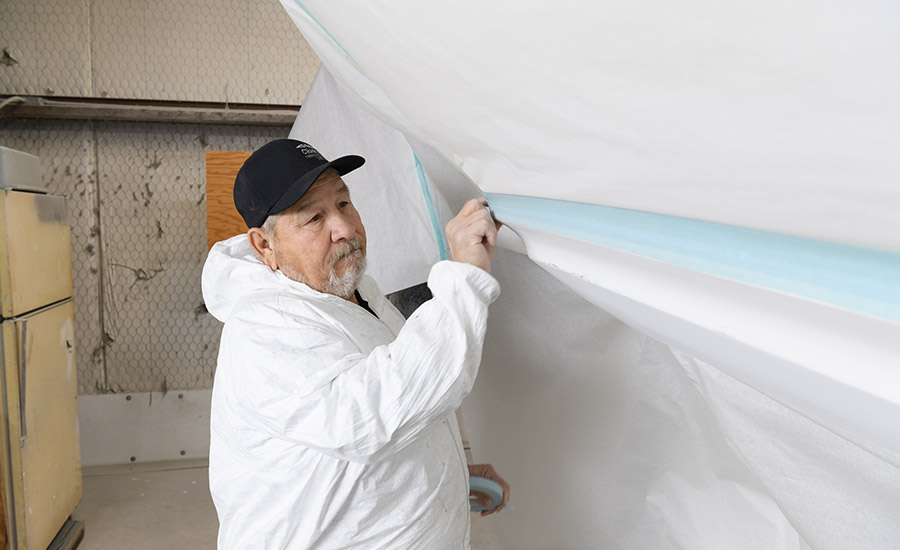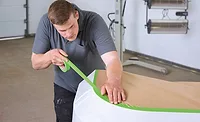Beyond Beige: High-Performance Masking Tape for Transportation Applications
The next generation of masking tapes is evolving beyond the typical beige off-the-shelf product offerings to address the rigorous demands of the transportation sector.

Dings, dents, scratches, and even large surface damage are unfortunately an all-too-common occurrence in the transportation sector. Boats, automobiles, buses, commercial fleets, and industrial equipment are all high-use machines, and accidental impacts often accompany that level of use. And while the time to restore the pristine surface of a truck body or the intricate design work on a boat hull may not be insignificant, the means to a professional finish is relatively straightforward: masking tape.
Masking tape is a critical component in a myriad of transportation-related industrial coatings and repair applications, helping to delineate coatings coverage and protect surfaces on not only marine vessels, but also buses, RVs, the automotive aftermarket, and more. The market potential for transportation coatings is huge and growing. From 2021-2031, demand for automotive refinish coatings alone is projected to grow at a CAGR of 5.4% to reach nearly $11 billion,1 while the market for marine coatings will see an even stronger 6.7% CAGR to top $4 billion by 2025.2
In applications such as gel coating a boat’s hull, applying a colorful design to a new fire truck, or repairing a vehicle’s paint job after a collision, masking tapes represent a sometimes overlooked but key component in the process. Not only is the tapes’ failure immediately visually apparent, but it is also time consuming and costly to correct.
Industry Needs
Traditionally, few high-performance masking tapes have been available to adequately address the specific requirements of these applications; the typical beige off-the-shelf masking tape is simply not up to the task. Ideally, tapes in these applications would be resistant to solvents and other chemicals, as well as ultraviolet (UV) light, while retaining adhesion on a variety of substrates at often high temperatures for potentially extended periods of time. In addition, they must feature strong adhesion to remain in place under harsh conditions, but they also need to remove easily without shredding (e.g., in long strips vs. small pieces) and without leaving a residue behind.
Developing new masking tapes to meet the rigors of these applications can be complicated. Long-standing institutional knowledge at the companies performing these services ultimately means that tape-related problems have often simply become part of the process, with employees thinking, “This is just the way we’ve always done it.” As a result, challenges and opportunities for improvement may not be readily apparent.
To fully understand the industry’s needs, tape manufacturers must cultivate strong relationships with their customers and prospects. The resulting trust enables the manufacturer to gain first-hand access to customer facilities in order to study the range of processes and products currently in use, identify specific potential issues and use the information gathered to develop products that address these needs.
Performance Variables
It can be challenging to identify the ideal balance of masking tape properties for the broad range of industrial coatings and repair applications in the transportation sector. Key factors to consider are temperature resistance, elongation and thickness, and tensile strength and adhesion.
Service Temperature
The curing process in these types of applications may be sped up with the incorporation of a “bake” cycle, where the component remains exposed to temperatures that can range from 40-325 °F for about 30-45 minutes. The masking tape must therefore be able to retain adhesion to the substrate at the required high temperature without curling or pulling off for the length of the cycle.
Following the bake, the component may immediately move to the next production step or be left for several hours (or even overnight), depending on the facility’s workload and capacity. In addition, the vehicle may be inside or outside and exposed to the elements during this time frame.
The environmental variability in these applications means that the tape should have the ability to be cleanly pulled from the substrate whether it is hot or cold, wet or dry. Any residue left after removal requires additional time and effort to remove, as well as solvents or other chemicals to facilitate the cleanup, all of which result in additional costs.
Elongation and Thickness
In transportation coatings and repair applications, masking tape is commonly applied to help delineate colors and intricate designs or to protect vehicle interiors and other surfaces that don’t require attention. The tape may be pulled, stretched, and applied in various curves and shapes to achieve the needed end result.

A tape’s elongation and thickness directly impact its ability to flex, conform, and retain its shape after it is applied to a substrate. Elongation refers to the tape’s capacity to stretch and rebound to its original shape. For tight curls, for example, the employee needs to be able to pull the tape and stretch it into the required shape without worrying about it pulling back and losing the desired line effect.
When it comes to thickness, thicker tapes are less effective for achieving intricate designs. Attempting to make a thick tape curve and achieve a tight corner results in creasing, which provides an opportunity for the coating to bleed through the desired line. Thinner tapes are better able to adjust to curves cleanly and smoothly, providing the sharp paint line customers expect.
Tensile Strength and Adhesion
Both tensile strength and adhesion relate to the tape’s ability to maintain its structure and remain bonded to the substrate. A tape’s tensile strength represents the stress it can endure before breaking when it is stretched or pulled. This is an important quality as the tape is peeled from the roll and applied or as it is removed from the substrate after the process is finished.
Adhesion simply involves the tape’s ability to maintain its bond with the substrate. Common surfaces in transportation applications can include metal, anodized aluminum, fiberglass, and others, so it is imperative that the tape is able to retain strong adhesion to a variety of surfaces.
Case in Point
A recently designed line of high-performance masking tape* is helping one boat repair and restoration company improve not only its productivity, but its employee morale as well. Located in Hickory, North Carolina, Mobile Marine Services Unlimited has been in business for 13 years. Specializing in fiberglass and gel coat repair, its customers include boat dealerships as well as individual community members in the Lake James and Lake Hickory area.
Whether the boats are damaged in transit from the factory to the dealership or as a result of an incident after purchase, repairs can be needed for issues such as fiberglass cracks or surface finish scratches. Masking tape is a key element in Mobile Marine’s operations to remedy these issues.
In fiberglass repair, for example, tape and plastic are used to mask off the boat’s interior from the effects of fiberglass grinding. To restore a gel coat or paint finish, masking tape could again protect the interior, as well as areas of the exterior that do not require repair and simply need to be safeguarded from the work in process.

According to Mobile Marine’s owner, Patrick Barlow, he and his two mechanics had previously been relying on whatever tape happened to be available. Problems with removability frequently arose, however, particularly when the tape was exposed to moisture. “Some of the tape that might get wet, if the boat was pushed outside, was extremely hard to clean off,” he explains.
Consistently achieving a fine paint line was also challenging. “Some of the tapes would bleed, along that fine edge,” Barlow says. “It took a large amount of time and energy to get it right.”
Switching to products in the new tape line has eliminated these challenges in Mobile Marine’s operations, ensuring both clean, easy removability and crisp, fineline edges for intricate designs. “The new tape pulls off and releases well vs. some of the other products I’ve used,” Barlow says. “It far exceeds expectations.”
“The guys that use it on a daily basis are really excited about the product,” he continues. “It performs a lot better than what we had been using, so they don’t have to deal with some of the headaches that the other tape was putting us through.”
Targeted Solutions
While it can be challenging to identify the specific needs of a particular industrial niche, building strong relationships within that industry can help tape manufacturers create targeted solutions. For coatings and repair applications in the transportation sector, recently developed high-performance masking tapes featuring temperature and chemical resistance, coupled with high durability and conformability, are improving efficiencies through ease of application and removal while providing high-quality finished products.
For more information, visit www.frogtape.com/performance and www.shurtape.com/fineline-masking.
*Tapes in the line include FrogTape® 225 Gold, 250 Light Blue and 325 Pink and Shurtape® FLC 280 Blue and FLS 325 Yellow from Shurtape Technologies.
References
- “Automotive Refinish Coatings Market Snapshot,” Future Market Insights, July 2022, https://www.futuremarketinsights.com/reports/automotive-refinish-coatings-market.
- “Marine Coatings Market by Type, Chemistry, Application, and Geography-Forecast and Analysis 2021-2025,” September 2021, https://www.technavio.com/report/marine-coatings-market-industry-analysis.
Article images supplied by Shurtape Technologies.
Looking for a reprint of this article?
From high-res PDFs to custom plaques, order your copy today!





